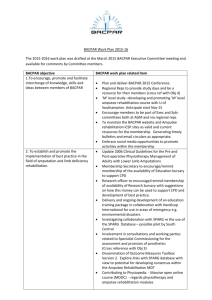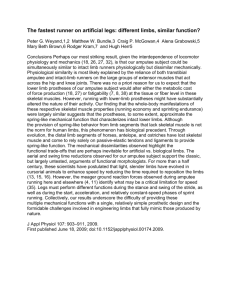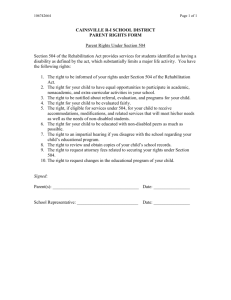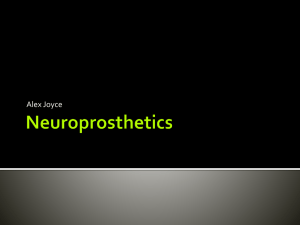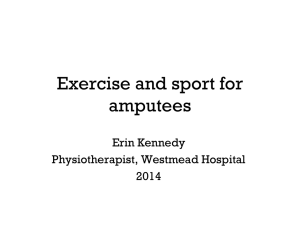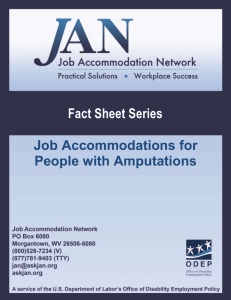amputee self-assessment tool - Australian Physiotherapists in
advertisement
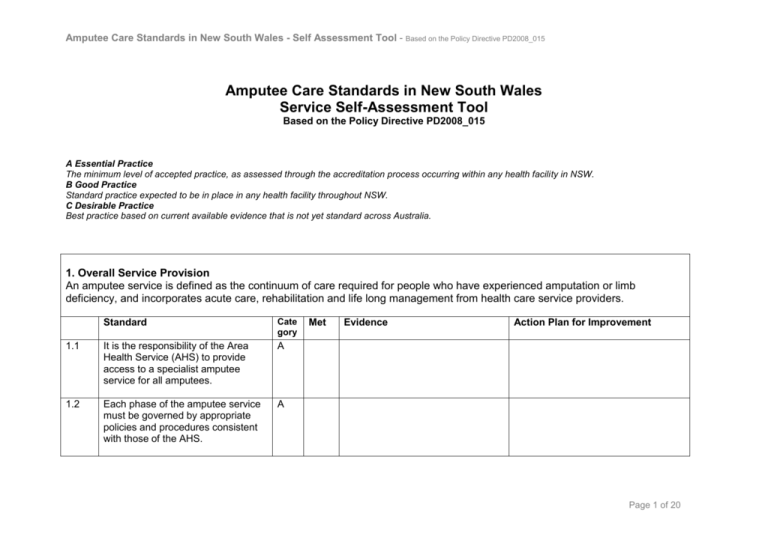
Amputee Care Standards in New South Wales - Self Assessment Tool - Based on the Policy Directive PD2008_015 Amputee Care Standards in New South Wales Service Self-Assessment Tool Based on the Policy Directive PD2008_015 A Essential Practice The minimum level of accepted practice, as assessed through the accreditation process occurring within any health facility in NSW. B Good Practice Standard practice expected to be in place in any health facility throughout NSW. C Desirable Practice Best practice based on current available evidence that is not yet standard across Australia. 1. Overall Service Provision An amputee service is defined as the continuum of care required for people who have experienced amputation or limb deficiency, and incorporates acute care, rehabilitation and life long management from health care service providers. Standard Cate gory 1.1 It is the responsibility of the Area Health Service (AHS) to provide access to a specialist amputee service for all amputees. A 1.2 Each phase of the amputee service must be governed by appropriate policies and procedures consistent with those of the AHS. A Met Evidence Action Plan for Improvement Page 1 of 20 Amputee Care Standards in New South Wales - Self Assessment Tool - Based on the Policy Directive PD2008_015 1.3 Each AHS where amputations are performed is to make provision for the rehabilitation of amputees who are not suitable for prosthetic rehabilitation. A 1.4 The AHS in which the patient resides is to make provision for patients whose needs are unable to be managed adequately within the patient’s local area. Where gaps exist in the phases of care the AHS must ensure that patients gain timely access to services. This may involve referral to another AHS to ensure access to appropriate specialist amputee services. A 1.5 Patients within any AHS are to have access to appropriate rehabilitation services that aim to maximise physical, psychosocial and cognitive wellbeing. A 1.6 All patients are to be given access to relevant information about lifestyle opportunities when living with an amputation. A 1.7 Patients are to have adequate access to relevant information in an appropriate format, including a A Page 2 of 20 Amputee Care Standards in New South Wales - Self Assessment Tool - Based on the Policy Directive PD2008_015 choice of language and access to interpreter services. 1.8 Each phase of the amputee service must have oversight from a suitably experienced clinician in amputee management. A 1.9 Each phase of the service is to reflect a staffing mix appropriate to the level of service being provided. A 1.10 The rehabilitation phase of care begins from the point of decision to amputate and appropriate interventions are to be undertaken from that time by the specialist team to assist recovery. A 1.11 The amputee service is to have access to appropriate prosthetic services. A 1.12 The transfer and/or discharge of patients is to be supported with appropriate documentation to assist in the patient’s ongoing health provision and care. A 1.13 The medical director of the amputee clinic (or their nominated delegate) should be the official representative B Page 3 of 20 Amputee Care Standards in New South Wales - Self Assessment Tool - Based on the Policy Directive PD2008_015 of the service with the ALS. 1.14 Amputee service should have established performance indicators and outcome measures for each phase of amputee care for continuous quality improvement purposes. Please refer to Appendix 3 for examples of suitable tools. B 1.15 Clinical input is to be sought in any decision-making regarding the planning, development and delivery of amputee services. A 1.16 Health facilities within the amputee service that provides prosthetic assessment, prescription or manufacturing services are to be accredited by the NSW Artificial Limb Service (ALS). A 1.17 Key stakeholders including patients and carers, should have opportunities to provide input into service planning and review processes. B 1.18 Amputee services should collect data at each phase of amputee care in line with NSW Health Department and ALS requirements and for the B Page 4 of 20 Amputee Care Standards in New South Wales - Self Assessment Tool - Based on the Policy Directive PD2008_015 purpose of accreditation. 1.19 Outpatient and day rehabilitation should be supported by adequate transport systems to ensure equity of access to services. B 1.20 Access to community support for those unable to travel to a rehabilitation centre, or for whom rehabilitation is more appropriately conducted in the context of their normal home environment, should be made available. B 1.21 Where possible, AHSs should assist in the provision of peer support to people with amputations. B 2. Pre-operative The pre-operative phase begins with the decision to amputate and continues to the point of surgery. 2.1 Standard Cate gory Facilities where planned amputations occur are to have access to a specialist team. This A Met Evidence Action Plan for Improvement Page 5 of 20 Amputee Care Standards in New South Wales - Self Assessment Tool - Based on the Policy Directive PD2008_015 includes, but is not limited to a suitably experienced surgeon, rehabilitation physician, prosthetist, nurse, occupational therapist and physiotherapist. 2.2 A pre-amputation consultation is to A be conducted for all planned amputations, with the patient and the rehabilitation team members who will be involved in rehabilitation after the surgery. 2.3 Experienced clinical counseling and psychological support is to be made available to patients and their significant others, particularly for those patients where amputation is unanticipated. This should begin in the acute phase and continue if required as part of lifelong management. A 2.4 Unless clinically contra-indicated a rehabilitation program should be commenced pre-operatively. B 2.5 All surgical departments should provide patients undergoing elective amputations with access to information regarding local peer support and/or amputee B Page 6 of 20 Amputee Care Standards in New South Wales - Self Assessment Tool - Based on the Policy Directive PD2008_015 associations. 3. Surgical This phase includes all issues relating to the amputation surgery. Standard Cate gory 3.1 Each hospital where planned amputations are performed is to have access to a surgeon with specialist expertise in amputation surgery. A 3.2 An amputation is to be performed or supervised by a suitably experienced surgeon using currently recognised operative techniques. All surgical interventions must take into consideration future rehabilitation potential and prosthetic use, except in cases of extreme urgency. A 3.3 The surgical team is to liaise with the A rehabilitation service to ensure continuity of care. 3.4 Rigid dressings should be applied Met Evidence Action Plan for Improvement B Page 7 of 20 Amputee Care Standards in New South Wales - Self Assessment Tool - Based on the Policy Directive PD2008_015 according to the NSW Health Guideline, Amputee care – the use of post-operative dressings in transtibial amputees. Refer to standard 6.2. 3.5 The NSW Department of Health A Dressing Data Collection Form is to be completed for all patients postoperatively whether a rigid or soft dressing is used. See the NSW Health Guideline on Rigid Dressings. 4. Post Surgical The post surgical phase incorporates the patient’s journey immediately post-operative until the patient is ready for rehabilitation. Standard Cate gory 4.1 All patients are to be referred for assessment by the rehabilitation team. A 4.2 All relevant clinical information, incorporating any special needs, is to be made available to the rehabilitation team at the point of referral. A Met Evidence Action Plan for Improvement Page 8 of 20 Amputee Care Standards in New South Wales - Self Assessment Tool - Based on the Policy Directive PD2008_015 4.3 All patients are to be assessed by the appropriate members of the multidisciplinary team to assist in the patient’s ongoing management and care. A 4.4 All patients are to be consulted about the outcome of assessments and their ongoing health care plan. A 5. Rehabilitation The Rehabilitation phase commences when the patient’s post-operative recovery permits. Rehabilitation aims to improve functional status with or without a prosthesis, and to successfully reintegrate the patient into their community. Comprehensive rehabilitation of the person with an amputation must take into account the whole person in the context of their environment and their goals. 5.1 Standard Cate gory All patients, including those who may not be a prosthetic candidate, are to be provided with an opportunity to participate in a rehabilitation program in accordance with the policies and procedures of the treating facility. A Met Evidence Action Plan for Improvement Page 9 of 20 Amputee Care Standards in New South Wales - Self Assessment Tool - Based on the Policy Directive PD2008_015 5.2 All referrals for rehabilitation should be acknowledged and suitable follow up provided in a timely manner. B 5.3 Rehabilitation is to be responsive to changes in the individual patient’s lifestyle, occupation and/or general health. A 5.4 All patients undertaking a rehabilitation program are to be assessed and realistic rehabilitation goals established in conjunction with the patient and/or carers. These goals and reasons for any inability to achieve goals are to be documented. A 5.5 When a prosthesis is not prescribed, reasons for the decision are to be clearly documented and alternative rehabilitation plans implemented. Outcomes must be reported back to referring agencies and the patient/carer. A 5.6 All patients should have access to members of the specialist team as required. B 5.7 The rehabilitation service should provide access to counseling and B Page 10 of 20 Amputee Care Standards in New South Wales - Self Assessment Tool - Based on the Policy Directive PD2008_015 support services consistent with the needs of the patient and their significant others. 5.8 All patients should be provided with referral/access to vocational support services where appropriate. C 5.9 Patients are to be educated about the care of their intact limb where a risk of amputation exists. A 5.10 The rehabilitation service is to have a system in place for managing patient review and follow-up based on appropriate assessment and referral criteria. A 5.11 The General Practitioner and other relevant agencies are to be regularly updated on progress and discharge planning via appropriate documentation. A 5.12 All patients are to be provided with suitable discharge arrangements and follow-up services based on their individual rehabilitation goals. A Page 11 of 20 Amputee Care Standards in New South Wales - Self Assessment Tool - Based on the Policy Directive PD2008_015 6. Rehabilitation with prosthesis This phase comprises all elements of prosthetic rehabilitation. Standard Cate gory 6.1 If prosthetic rehabilitation is planned, the prosthesis should be prescribed in consultation with relevant members of the multi-disciplinary team. B 6.2 A mechanical interim prosthesis A manufactured by a prosthetist is to be made available to all amputees assessed as suitable for prosthetic rehabilitation. This is not required for amputees who are only suitable for a cosmetic prosthesis. The NSW ALS will fund the manufacture of a patient’s mechanical interim limb where AHS has implemented the NSW Department of Health Guideline, Amputee care – the use of post-operative dressings in transtibial amputees, by 1 January 2008. Refer to standard 3.4. Training on the application of rigid dressings is available through the NSW ALS. Cost savings for AHSs as a result of this change are to be redirected into Met Evidence Action Plan for Improvement Page 12 of 20 Amputee Care Standards in New South Wales - Self Assessment Tool - Based on the Policy Directive PD2008_015 compliance with this policy directive. 6.3 Prosthetists are to follow the manufacturers’ instructions and guidelines on risk management and any deviations from standard practice are to be fully documented. A 6.4 If the patient abandons limb use, reasons are to be documented and the treating physician informed. A 6.5 The amputee service should have a written and agreed policy for the provision of prosthetic limbs such as a cosmesis, leisure limbs, and water activity limbs to patients. For clients of the NSW Artificial Limb Service, please refer to the NSW ALS policy. B 6.6 Facilities for the design and supply of custom made/one off appliances required for amputees, especially for work related activities, should be available and managed within the policies and procedures of the treating facility. For clients of the NSW Artificial Limb Service, please refer to the NSW ALS policy.s B Page 13 of 20 Amputee Care Standards in New South Wales - Self Assessment Tool - Based on the Policy Directive PD2008_015 7. Lifelong management This phase acknowledges the fact that the patient will be a service consumer for the remainder of their life and the standards reflect life long management issues. Standard Cate gory 7.1 All service facilities are to have a written policy on patient follow-up. A 7.2 The amputee service is to offer the patient access to the rehabilitation team for the purpose of review to meet the changing needs of individual patients. A 7.3 Feedback to the treating physician and any other relevant services should be provided on follow-up when clinically indicate. B Met Evidence Action Plan for Improvement 8. Staff Development This policy includes standards pertaining to continued professional development for staff. Standard Cate gory Met Evidence Action Plan for Improvement Page 14 of 20 Amputee Care Standards in New South Wales - Self Assessment Tool - Based on the Policy Directive PD2008_015 8.1 Systems for continuous quality improvement and clinical governance are to be linked to the appropriate accreditation procedure. There must be a system of regular appraisal for all staff. A 8.2 All amputee services are to undertake quality improvement activities as a routine part of clinical practice. A 8.3 Each phase of the amputee service is to have a written policy on staff training and professional development. A 8.4 Staff should be actively encouraged to attend relevant educational forums to enhance their skills and knowledge in amputee care. This should include national and international conferences. B 8.5 Opportunities should be sought for multi-disciplinary and inter-agency education and training about the management of patients with amputations or limb deficiencies, including the involvement of patients in the management of their disability. C Page 15 of 20 Amputee Care Standards in New South Wales - Self Assessment Tool - Based on the Policy Directive PD2008_015 8.6 All professional staff are to be updated on current best practice in amputee care. A 8.7 Staff should have access to current health literature relevant to their role within the amputee care pathway. B 8.8 Adequate funding should be available to ensure all staff have access to appropriate educational forums. B 8.9 Staff working with Aboriginal patients A are to participate in cultural respect training. 9. Specialist Subsection – Upper Limb It is recognised that upper limb amputee patients require specific recommendations pertaining to their care. 9.1 Standard Cate gory During pre-amputation consultation for upper limb amputees, particular emphasis should be placed on the likely functional outcome with or without a prosthesis. B Met Evidence Action Plan for Improvement Page 16 of 20 Amputee Care Standards in New South Wales - Self Assessment Tool - Based on the Policy Directive PD2008_015 9.2 All upper limb amputations are to be carried out by an appropriately experienced upper limb surgeon using currently recognised upper limb amputation techniques with due consideration of future rehabilitation potential including prosthetic use, except in cases of extreme urgency. A 9.3 Experienced clinical counseling and psychological support is to be made available to all patients to assist with issues such as adjustment and pain management. A 10. Specialist Subsection - Children with Congenital Limb Deficiencies It is recognised that children with congenital limb deficiency require specific recommendations pertaining to their care. 10.1 Standard Cate gory If a limb deficiency is detected antenatally, referral to a geneticist for advice on diagnosis and management should occur as soon as possible with subsequent referral to a Limb Deficiency Clinic. B Met Evidence Action Plan for Improvement Page 17 of 20 Amputee Care Standards in New South Wales - Self Assessment Tool - Based on the Policy Directive PD2008_015 10.2 If a congenital limb deficiency is detected at birth, the paediatrician should make a referral to a geneticist for advice as soon as possible and to the rehabilitation physician in the Limb Deficiency Clinic within one month of birth. B 10.3 Parents/guardians are to be made aware of general and specific expert advice on all relevant treatment options (including the advisability or otherwise of prosthetic and surgical management). A 10.4 The child and parents/guardians should be seen in a Specialist Limb Deficiency Clinic within 3 months of birth. B 10.5 Where appropriate (for example where there are major joint abnormalities) the paediatrician or rehabilitation physician must, in consultation with parents/guardians, refer the child to a specialist orthopaedic surgeon. A 10.6 All children with congenital limb deficiency are to have access to a therapist experienced in the A Page 18 of 20 Amputee Care Standards in New South Wales - Self Assessment Tool - Based on the Policy Directive PD2008_015 management of limb deficiency. 10.7 Prosthetists experienced in congenital limb deficiency are to be involved in the assessment, treatment and ongoing management of all children with congenital limb deficiency. A 10.8 Expert orthotic advice and treatment should be readily available. B 10.9 Specific prosthetic solutions should be incorporated into treatment plans to facilitate participation in sport, leisure and recreation. B 10.10 Participation in school activities should be facilitated by the physiotherapist, occupational therapist and rehabilitation physician in consultation with the school. B 10.11 The multi-disciplinary team is to provide ongoing care for the child and parents/guardians with an appropriate and documented followup plan. A 10.12 Experienced clinical counselling and psychological support is to be made available for all children and their A Page 19 of 20 Amputee Care Standards in New South Wales - Self Assessment Tool - Based on the Policy Directive PD2008_015 families. 10.13 Planning for transition to an appropriate adult amputee service is to commence one to two years prior to school leaving. A Page 20 of 20
